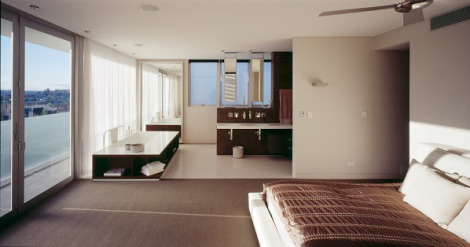As there’s only 30 days left before the start of Eurocucina and the International Bathroom Exhibition, I was interested to read this article from KBB in the UK. Minamalistic tones are often at the forefront of displays we encounter, but this raises some very poignant points.
Glasgow bathroom retailer, and regular kbb review columnist, Derek Miller wonders whether modern minimalism has killed the traditional bathroom…”Around the start of the new millennium, popular attitudes about design began to shift towards all things sleek and European. Customers began to chant the mantra of ‘clean lines with no fuss’, and the populace worshipped at the shrine of the great god Minimalism. Architects across the country nodded sagely and slipped into plain black suits to become champions of all things straight and angular. For the bathroom space, this drove a fundamental shift away from fitted furniture towards bulkheads, and seemingly announced the death knell for the humble pedestal and close-couple pan. Brightly coloured tiles with vivid borders made way for natural shades and mosaics, and it became an aesthetic offence to display mixer taps in the showroom environment. All services were to be hidden from view, to create a Zen-like calm where we could all be quietly pleased with ourselves. 
The traditional, period feature bathroom with its fluted pedestals, elaborate basins and pillar taps appeared to be the biggest casualty of this move towards all things contemporary. The sheer opulence of Victorian styling was seemingly out of touch and was left, by the large manufacturers, to die a lingering death as a mere footnote to bathroom history. German, Italian, Japanese, and Scandinavian style was in. British tradition was out. Or was it?
I remember visiting CP Hart in Waterloo about five years ago and, noting the number of old-fashioned styles that were on display, asked whether they felt that traditional bathrooms were making a comeback? MD Paul Rowland stifled an urge to snigger at my provincial naivety and said that, contrary to popular belief, they had never, ever been away. Paul was absolutely correct in this judgement. Over the years, period bathrooms, whether Victorian, Edwardian, or Art Deco, have retained a resilient niche within our industry. In past years, their cause was championed by successful entrepreneurs such as Barrie Cutchie with BC Sanitan and Gary Lake with Heritage. More recently, Patrick Riley has blazed the trail with Burlington Bathrooms – the biggest selling range in his popular Bathroom Brands portfolio.
The success of these operators has been down to a firm grasp of product detail as well as an innate understanding of what makes retailers and consumers tick when it comes to bathroom selection. They also understood that the traditional bathroom offer had to be as authentic as possible and, more importantly, had to be presented properly within the showroom environment and in marketing materials.
At the high-end of the traditional market, Imperial has continued to fly the flag for Britain, and is one of the few brands from which a client can specify the entire bathroom – tiles, lights, and radiators included. There are also über-specialists in the market: Lefroy Brooks has beautifully crafted pieces representing specific eras, and the revived Thomas Crapper brand offers the final word in bona fide originality.
Traditional bathroom styles can be beautiful and offer an elegance that contemporary styles can only aspire to. Such ranges may not be to everyone’s taste, but few could argue with the sheer country-house appeal of a roll-top bath with ‘telephone handset’ filler, a high-level cistern with pull flush, or small-format antique cracked glazed tiles in rich, vibrant colours. From Edinburgh’s Georgian New Town to London’s Edwardian terraces, from Glasgow’s Victorian tenements to Bath or Cheltenham’s Regency crescents, traditional bathroom ranges reflect the fabric, scale and detail of period properties and as such will always play an important role in the British bathroom industry. They may have less than 10% of the market, but the small number of suppliers in the field ensures that money can still be made by those involved in traditional bathroom supply. In the international environment, traditional bathroom styles are seen as quintessentially British, so there are undoubted export opportunities for the suppliers also.”
So the big question for our growing readership is this. Is this indicative of thinking here, or, as we’ve seen at recent debates, do we maintain our own identity?
Have your say guys!































